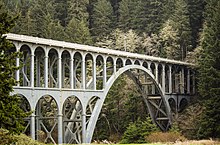Cape Creek Bridge No. 01113 | |
 | |
| Location | |
|---|---|
| Coordinates | 44°08′01″N 124°07′19″W / 44.13361°N 124.12194°W |
| Built | 1932 |
| Architect | Conde B. McCullough |
| MPS | C. B. McCullough Major Oregon Coast Highway Bridges, 1927-1936 MPS |
| NRHP reference No. | 05000820 |
| Added to NRHP | 2005 |

Cape Creek Bridge is an arch bridge that spans Cape Creek in Lane County, Oregon, United States. The bridge carries U.S. Route 101. Opened in 1932, it was designed by noted bridge engineer Conde McCullough and built of reinforced concrete by John K. Holt. [1] [2] The total length of the bridge is 619 feet (189 m), with a main span of 220 feet (67 m). [1] The bridge resembles a Roman aqueduct, with a single parabolic arch that spans half its length. [2] It was listed as Cape Creek Bridge No. 01113 on the National Register of Historic Places in 2005, as part of the C. B. McCullough Major Oregon Coast Highway Bridges MPS ( Multiple Property Submission).
Corrosion protection
The Cape Creek Bridge has been impressed-current cathodically protected (ICCP) from corrosion since 1991. Rebar in concrete is highly susceptible to corrosion by chloride ions from seawater and de-icing salts. Contractors to the Oregon Department of Transportation have plasma-sprayed 102,000 square feet (9,500 m2) of 0.020-inch-thick (0.5 mm) zinc onto the exposed concrete to provide a sacrificial anode that corrodes in lieu of the steel rebar. [3] [4] [5] [6]
See also
-
 Transport portal
Transport portal -
 Engineering portal
Engineering portal  Oregon portal
Oregon portal- Heceta Head
- List of bridges documented by the Historic American Engineering Record in Oregon
- List of bridges on the National Register of Historic Places in Oregon
- List of bridges on U.S. Route 101 in Oregon
References
- ^ a b Hadlow, Robert W. (2001). Elegant Arches, Soaring Spans: C. B. McCullough, Oregon's Master Bridge Builder. Corvallis, Oregon: Oregon State University Press. ISBN 0-87071-534-8.
- ^ a b Style & Vernacular: A Guide to the Architecture of Lane County, Oregon. Western Imprints, The Press of the Oregon Historical Society. 1983. p. 151. ISBN 0-87595-085-X.
- ^ Cape Creek Bridge Cathodic Protection Operating Data: 1992-94 (Report). Oregon Department of Transportation. 1995.
- ^ Brousseau, R.; Arnott, M.; Baldock, B. (August 1995). "Laboratory Performance of Zinc Anodes for Impressed Current Cathodic Protection of Reinforced Concrete". Corrosion. 51 (8): 639–644. doi: 10.5006/1.3293625. S2CID 138448127.
- ^ Covino, B. S. Jr.; Bullard, S. J.; Holcomb, G. R.; Cramer, S. D.; McGill, G. E.; Cryer, C. B. (May 1997). "Bond Strength of Electrochemically Aged Arc-Sprayed Zinc Coatings on Concrete". Corrosion. 53 (5): 399–411. doi: 10.5006/1.3280483.
- ^ Holcomb, G. R.; Covino, B. S. Jr.; Russell, J. H.; Bullard, S. J.; Cramer, S. D.; Collins, W. K.; Bennett, J. E.; Laylor, H. M. (November 2000). "Humectant Use in the Cathodic Protection of Reinforced Concrete". Corrosion. 56 (11): 1140–1157. doi: 10.5006/1.3294399.
External links
- Historic American Engineering Record (HAER) No. OR-41, " Cape Creek Bridge, Spanning Cape Creek at Oregon Coast Highway, Florence, Lane County, OR", 15 photos, 6 data pages, 2 photo caption pages
- Open-spandrel deck arch bridges in the United States
- Oregon Coast
- Road bridges on the National Register of Historic Places in Oregon
- Bridges completed in 1932
- U.S. Route 101
- National Register of Historic Places in Lane County, Oregon
- Bridges in Lane County, Oregon
- Concrete bridges in Oregon
- Historic American Engineering Record in Oregon
- Bridges by Conde McCullough
- Bridges of the United States Numbered Highway System
- 1932 establishments in Oregon
- Western United States bridge (structure) stubs
- Oregon building and structure stubs
- Oregon transportation stubs
- Oregon Registered Historic Place stubs